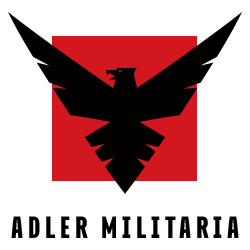Showing 1–9 of 33 resultsSorted by latest
-
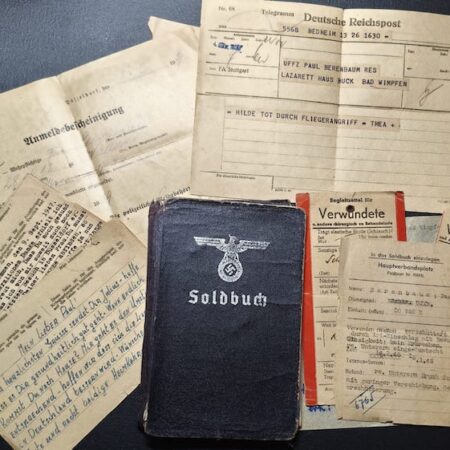
WWII Wehrmacht Soldbuch Grouping – Uffz Paul Berenbaum – Born in France! – Incredible Story Buried Alive by US Artillery – Grenadier Regiment 713 – 416 Inf Div West Wall 1945 – Mortar Team Leader – Rare!
$565.00Here we have a really tragic Soldbuch Grouping… Paul Berenbaum was born in Wallern (Vallieres Les Metz) France. He was enlisted into the German Army in February 1940. In 1940/1941 he served with: Infanterie Regiment 178 – 76 Infanterie Division – On the Western Front then in Poland. In 1942 he served with: Infanterie Regiment 441 – 416 Infanterie Division They served in Denmark, more can be found here including the places in which they were posted: https://www.lexikon-der-wehrmacht.de/Gliederungen/Infanteriedivisionen/416ID.htm In 1943/44 he served with Landeschützen Regiment 930 shortly before being assigned to Grenadier Regiment 713 in late 1942/early 1943. But by late 1944 he was assigned to the Feld Ersatz Batl 476 – 416. Infanterie-Division Issued a MP40 Machine Pistol On October 11, 1944, the division established a command post in Keuchingen near Mettlach/Saar. After the start of the Allied offensive across the Moselle on November 9, 1944, elements of the division were deployed in the ensuing defensive battles around Freching and Kerling. On November 17, 1944, the division’s command post was located in Tünsdorf, on November 18 in Orscholz, and on November 19 in Trassem. On November 28, the division headquarters was in Taben, and on December 3 in Taben-Rodt. On December 4, 1944, after a month of defensive fighting, the division still had a combat strength of 2,400 men, of whom 1,550 were infantry. Heavy fighting ensued around the West Wall, followed by a retreat to the Mettlach area and the Orscholz ridge. On January 14, 1945, the division still had a strength of 3,016 men. In the following weeks, the fierce defensive battles continued at the Orscholz ridge/Saar-Moselle triangle. Between February 7 and 28, 1945, the division suffered 2,195 casualties. According to his wounding tags, he was delivered on the 15.1.1945 in St Wendel with a suspected broken bone from being stuck/squeezed. According to a rather rare (never seen before) Soldbuch Paper which was to be put into the Soldbuch given by the main aid station (Hauptverbandplatz): “Verschüttet durch Artillerie einschlag mit Bewusstlosigkeit; kein erbrechen rechten unter arm eingequetscht” “Buried by artillery fire, unconscious; no vomiting, right arm crushed” After being examined the Doctor found his right arm was broken at the elbow, and he was suffering from concussion. He was transferred to Bad Wimpfen where he was to rest according to another piece of paper issued by the Hospital, although he would get a Telegram from his Wife that his relative Hilde was killed during an allied bombing raid on the 4th of March 1945. He would spend till the 28th of May 1945 in hospital recovering, before going into a POW Camp Nr 172 in Vernet d Àviege which was in fact a former Concentration Camp. https://en.wikipedia.org/wiki/Camp_Vernet Two Letters sent by his friend Julius Niggemann in 1947 read: My dear Paul! Warmest greetings from Julius. I hope you are in good health. When will you finally come home? Considering the circumstances, we hope that the situation in Germany will soon improve. I wish you all the best and a speedy return home – your Julius! My dear Paul! With heartfelt thanks I received your kind lines. I am glad to hear that you are still healthy and in good spirits — as far as I can say, I am as well. During my last visit to Düsseldorf, I unfortunately learned of the death of your dear wife. You must come to terms with this sad fact, however difficult the loss must be for you. I do hope now, with confidence, that you will soon be released. It truly is about time that our authorities finally come to that realization as well. Düsseldorf looks desolate, and yet, despite everything, new life is springing up from the ruins again. I am always amazed at how people manage to carry on with life. For today, I wish you all the best. Stay healthy and in good spirits until we can have a joyful reunion back home. Your ever-thoughtful friend. It seems his wife Thea Berenbaum died in December of 1945. Lastly a letter dated 18.6.1948 to the now released Paul Berenbaum living in the British Zone of Germany in Munster / Westfalhen shows that he made it out alive. Last comments His story is a tragic story, from being buried alive in combat and miraculously being pulled from the rubble unconscious, loosing family by bombing raids and later his wife whilst he was interned in a former Concentration Camp. A horrible time he experienced, one can only hope he lived peacefully after the war.
-
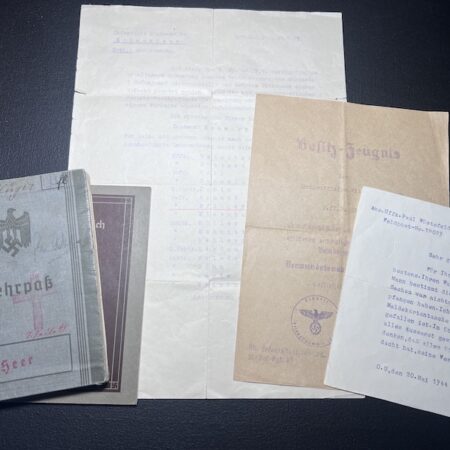
WWII German Wehrmacht Wehrpass KIA Grouping -Oberfeldwebel Pflüger – Saar Offensive 1939 Action Report – IR81 WIA France 1940 – Black Wounds Badge Certificate Le Hamal (Rare version!) Streifendienst – Grenadier Regiment Lublin
$375.00Interesting little grouping to Oberfeldwebel Pflüger Very interesting and unusual entry is that in September of 1939, he took part in the battle known as the Saar Offensive – when France invaded the Saarland in 1939!! “During a reconnaissance operation carried out by the 9th Company on 27 September 1939, despite difficult circumstances (captured prisoners, heavy rain, and several French soldiers put out of action), the mission was successfully completed. Through exceptional prudence and execution of the operation, it was possible to achieve success with minimal own losses.I express my recognition to the leader of the reconnaissance patrol” He was fighting in France with Infanterie Regiment 81, and was injured in a battle with French Soldiers in Le Hamal in June 1940. Medals: West Wall Medal, Iron Cross, Wounds Badge in Black He would serve in various other units including Streifendienst! Not often seen! He was later killed in action with Grenadier Regiment Lublin in Poland 1944. Final Comments The fact that he was involved in operations in September 1939 makes this grouping one of a kind, not many units actually took part in the fighting during the Saar Offensive, but having the typed letter naming him surely makes this quite a desirable item.
-

-
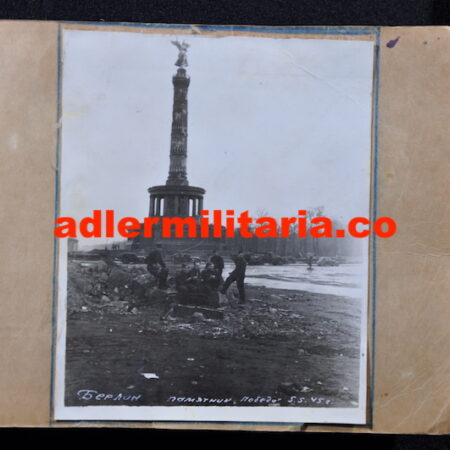
Original WWII Soviet Pilots Photo Albums – Epic Photos of Berlin in Ruins April 1945! – Ultra Rare
$975.00Here we have the photo albums of Soviet Pilot / Photographer : Ivan Ivanovich Puchko These images of Berlin in ruins are unpublished and extremely rare. Soviet Photoalbums for the Battle of Berlin are non existent, due to the lack of photo material in the Red Army for personal use. Any copying of the photos is strictly prohibited.
-

Original WWII German Propaganda for Germans! – Deutsche Volksgenossen! – Fully Translated – Rare
$245.00The leaflet is addressed to “Deutsche Volksgenossen!” (German compatriots!) and was designed to instruct civilians in occupied or soon-to-be occupied territories on how to behave when Allied forces advanced into their towns and cities. German Comrades! Although our heroically fighting soldiers have done everything in heavy battles and exemplary bravery to repel the enemy, he has penetrated into our Lower Rhenish homeland.If you now have to live under foreign occupation, then be aware that you have great duties towards your people and Führer, your fighting sons and fathers. The entire nation looks to you!The fallen call upon you! Ask yourselves, in every difficult situation, what is expected of you, and then act as is right. What is expected of you? How should you behave? 1. You must uphold the honor of your great nation.If the enemy proclaims: “Germany will collapse the moment our soldiers set foot across its borders,” then he has deceived himself.Prove to the enemy that you will never surrender your honor.Whoever forgets dignity and honor is despised not only by us but even more so by the enemy. 2. Whoever cooperates with the enemy, whoever gives voluntary assistance to the hostile military power, commits treason against Germany. 3. No German will consider the enemy worthy of even a glance, none will converse with him, none will associate with him. 4. Should anyone be found who betrays his honor, he will be despised and treated worse than the enemy himself, for he is a traitor. 5. If they force you under duress to perform services, remember the names of the units, officers, and officials; in due time they will not escape just punishment. 6. When you see the ruins of your cities and villages and see the enemy soldiers, then you see the criminals at the scene of the crime. If the enemy asks you the way, show him the way to the cemeteries where thousands of Rhineland men, women, and children are buried, murdered by this very enemy. If anyone says that the English and Americans are innocent, remember how many innocent women and children were horribly killed under their carpet bombings and in the infernos of fire. 7. If the enemy demands services from you, you have the right to refuse. You can rely on international law, the Hague Convention of October 18, 1907, signed by all states. The article reads:“Services and deliveries can be demanded from municipalities or inhabitants only for the needs of the occupying army. They must be proportionate to the resources of the country and of such a nature that they do not force the population to take part in military actions against their homeland.”You must therefore refuse any service that would aid the enemy army in its war against Germany. 8. Do not look at newspapers, leaflets, or printed matter distributed by the enemy. Do not listen to his radio. Let his films roll before empty benches, despise every amusement and distraction with which the enemy wants to ingratiate himself with you. For every hour that you indulge in such things, German soldiers and civilians are dying under his bombs and shells. 9. Do not grant the enemy any applause when he stages a military spectacle. Every hostile column must pass through a gauntlet of contempt. Not a single enemy soldier should feel comfortable for even one hour in our land. No one among you should allow it to be said that the Germans fight like lions in the field but behave like tame lambs at home. 10. No woman and no girl must ever show the enemy the slightest kindness. Above all, her honor must remain untouchable, for the honor of the woman is the honor of the entire nation. 11. The more sharply you reject the enemy, the more you close ranks as Germans. Help one another in your distress. Stand by each other as you have done in the nights of bombing, without orders, without command, and without reminder. The enemy has refused to believe that we were a united, content, socially advancing people. Prove to him how united we are and how unbreakable our cohesion is. Let it be read on our foreheads and in the eyes of every German person that no word of the enemy penetrates our hearts. We have a cause to defend, for which millions of Germans have already given their lives, and for which an entire people continues to fight. So be worthy and fight on! Our heroically fighting soldiers will return! Long live Germany!Long live the Führer!
-

Original WWII German Propaganda Leaflet – Antisemitic – Rare
$75.00A really rare leaflet dropped by German Propaganda Units on Soviet Trenches to try and get them to surrender. Translation This pass is valid for an unlimited number of commanders and soldiers of the Red Army who cross over to the side of the German troops. The bearer of this, not wishing senseless bloodshed for the interests of Jews and commissars, leaves the defeated Red Army and crosses over to the side of the German Armed Forces. German officers and soldiers will receive the one crossing over well, feed him and arrange work for him. Commanders and fighters of the Red Army! Your situation is hopeless.The iron ring of German troops is tightening tighter and tighter around you.You lack ammunition, supplies, and food; your rulers and leaders are incapable of anything, they flee and abandon you to fate.Many of you have been oppressed until now, deprived of rights — now you are being used only to defend their regime. Your struggle is useless!Is it really permissible that your command, out of stubbornness, still drives you mercilessly to inevitable death?No — your life is dear! Save it for a better future and for your families. Cross over to the Germans — there you will find good treatment and food, as well as a quick return home. Hurry!In the areas occupied by them, the Germans have already begun resolving the land question. Red Army soldiers, do not delay, otherwise you will be left without land! Headline (Russian): “Beat the Jew–political commissar, his mug begs for a brick!”(antisemitic slogan, repeated twice on the page) Top image caption:“Commissars and political instructors force you into senseless resistance.” Bottom image caption:“Drive away the commissars and cross over to the Germans.Cross to the Germans using either the slogan or the pass:” Final Comments: This is an extremely rare historical item and is only sold for historical purposes. They are filled with propaganda, disinformation, and hate speech.
-

Oil Painting by Ernst Frommhold – “Feldbergblick” – Famous Third Reich Artist – Reichsführung SS – Deutsche Kunst 1944
$995.00Here we have a rather odd item for a change! Feldbergblick by Ernst Frommhold Ernst Frommhold (* November 17, 1879 in Leipzig; † June 24, 1955 in Leipzig) was a well-known German landscape and marine painter. Ernst Frommhold came from a farming family living in the Leipzig area. After completing school, he was not allowed to study painting at the Leipzig Art Academy, as he had chosen to do, but instead had to complete an apprenticeship as a merchant and eventually became self-employed in this field. He continued the artistic pursuits he had devoted himself to since childhood in his free time. Numerous study trips took him to Italy, Switzerland, and twice on a steamship across the North Sea to the coast of Iceland. After the inflation following the First World War, he gave up his business and made his living exclusively from painting. In order to gain the necessary professional recognition, he planned to study at the Academy in Leipzig after all. There, however, he is said to have received a warning from Professor Hey that he could no longer teach him anything new and that Frommhold should simply continue as before. Frommhold was represented with six paintings at the Great German Art Exhibition in Munich in 1937, 1938, 1939, and 1940. Of these, “In the Heart of Greater Germany” was purchased by Emil Georg von Stauß, General Director of the Deutsche Bank, in 1939, and “Fertile Land” was purchased by the Reich SS leadership in 1940. In 1951, the artist moved to Karlsruhe, where he drew particular inspiration from the neighboring Black Forest in his final years. Having just recovered from a heart condition, he died unexpectedly in 1955. More information about his paintings during the TR. https://www.gdk-research.de/db/apsisa.dll/ete Price includes shipping and handling.
-
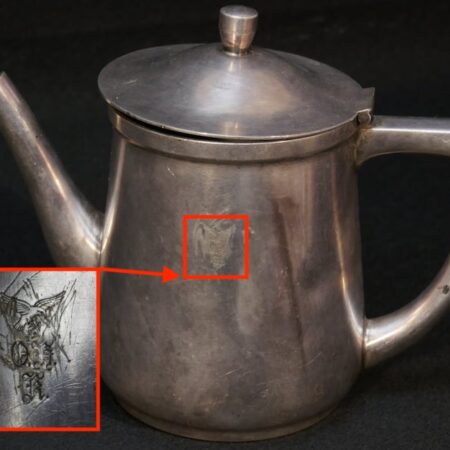
Original WWII German Luftwaffe Silver – 1.L Tea Pot – Luftwaffe Offiziersheim Kaufbeuren – Fliegerhorst Kaufbeuren- Rare
$385.00Here we have a really nice Luftwaffe Officers Mess item, marked with O.H.K – for Offiziersheim Kaufbeuren. This was found in Ireland in 2024, likely a British Army bring back after WWII The Swastica and Luftwaffe Adler has taken some beating, although this could be polished out to some extent/restored as I have been told. The maker of this item is: Württembergische Metallwarenfabrik, in Geislingen and der Steige. History of the area: In 1934, the city of Kaufbeuren sold the property on Apfeltrangerstraße to the German Reich. It was previously home to the “Tänzelhölzle,” a small wooded area with the Tänzelfest dance floor and labyrinth. Construction began in 1934, and the Reich Labor Service was among those involved. The first recruits were officially welcomed by Mayor Hans Wildung and other city dignitaries on October 29, 1935. The first permanent personnel of the newly established Kaufbeuren Aviation Training Center arrived at the facility on September 16, 1935. The first commander of an aviation replacement unit was Karl David (Karl Deinhardt from 1938 onward), who had been promoted to lieutenant colonel just a few weeks earlier. From October 1, 1936, the 25th Air Replacement Detachment was stationed there, which became the 23rd Air Replacement Detachment on November 1, 1938, both under Deinhardt’s command. On April 1, 1939, the 23rd Air Training Regiment was formed, consisting of the 1st Training Battalion of the 23rd Air Replacement Detachment and the Kaufbeuren Pilot Training School. International training was provided at Kaufbeuren Air Base during the pre-war period: in 1938, Spaniards and Romanians were stationed there, and in 1939, Bulgarians were still there for training. In addition to the training unit, an air base company was stationed at the air base for guarding, ground defense, anti-aircraft defense, and supplying the air forces. In November 1939, the air training unit and the pilot training school were relocated. The training battalion was relocated to Döberitz-Elsgrund, the pilot training school to Jüterbog-Damm, and a transport unit was stationed at the air base instead. From May 1940 until the end of the war, the pilot training school was stationed in Kaufbeuren again. The pilot training battalion returned to Kaufbeuren in June 1940 and was relocated to Belfort and Montbéliard in the summer of 1942. It was succeeded by a replacement battalion, which was responsible for replenishing the Afrika Korps’ material and personnel. At the same time, soldiers from the North African front came to Kaufbeuren for recuperation. From April to June 1942, Liaison Squadron 62, which had been disbanded in November 1941, was reorganized in Kaufbeuren and flew to the southern Russian front on June 14, 1942. From August to October 1944, III./KG 26 (III. Group of Kampfgeschwader 26) was stationed here. The air base was marked on Allied air force maps, but was only listed as a backup target throughout the war and, along with the town of Kaufbeuren, was spared major air raids. Air surveillance was controlled from the “Skihütte” in Oberbeuren, about one kilometer away. The air reporting and analysis center was located in the building, elevated on a slope. This center was designed to warn the air base crew of approaching enemy aircraft. In this case, the air base was evacuated, and the ski hut was used as the command post for the commanding officers. End of the War and Takeover by the US Air Force The pilot training school was officially disbanded on April 2, 1945, and a combat battalion was formed from the remaining soldiers. On the morning of April 27, 1945, the air base was completely evacuated. The American ground troops found the air base deserted but largely intact. After the Second World War, the Advanced Landing Ground (ALG R-70), as it was originally designated by the Allies after being occupied by the Americans, was used as “Kaufbeuren Air Base” by the United States Army Air Forces (from 1947 the United States Air Force). The facility was handed over to the Federal Republic of Germany on December 14, 1957, and continued to be used as an air base for the newly formed Bundeswehr.
-

Original WWII German General Gause Photo Album – Rommel Inspection Denmark 1943 – Sabotage Troops – Atlantic Wall – Hanstholm – Very Rare Images
$5,130.00Extremely Rare Images of Rommel In Denmark Taken By General Gause.
